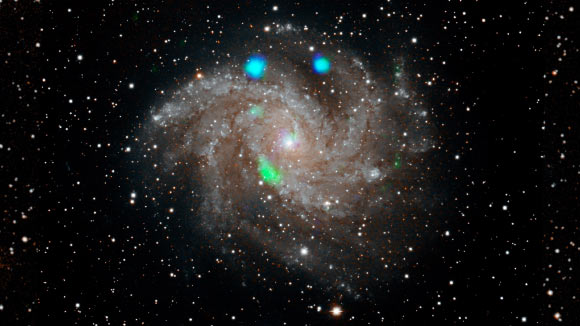Astronomers using NASA’s Nuclear Spectroscopic Telescope Array (NuSTAR) have found a remarkable source of X-rays in NGC 6946, a spiral galaxy located at a distance of about 25 million light-years.

This visible-light image of NGC 6946 comes from the Digital Sky Survey, and is overlaid with data from NASA’s NuSTAR observatory (in blue and green). ULX-4 is the green blob near the bottom of the galaxy. Image credit: NASA / JPL-Caltech.
In 2017, NuSTAR observed the NGC 6946 galaxy twice in order to study a recently-discovered supernova. The two observations were taken 11 days apart.
The extremely bright source of X-rays — the so-called ultraluminous X-ray source (ULX) — wasn’t visible during the first NuSTAR observation but was burning bright at the start of a second observation 10 days later.
NASA’s Chandra X-ray Observatory later observed that the source — named ULX-4, because it is the fourth ULX identified in NGC 6946 — had disappeared just as quickly.
No visible light was detected with ULX-4, a fact that most likely rules out the possibility that it is a supernova.
“Ten days is a really short amount of time for such a bright object to appear,” said Caltech astrophysicist Hannah Earnshaw.
“Usually with NuSTAR, we observe more gradual changes over time, and we don’t often observe a source multiple times in quick succession. In this instance, we were fortunate to catch a source changing extremely quickly, which is very exciting.”
Dr. Earnshaw and colleagues explored the possibility that the light came from a black hole consuming another object, such as a star.
If an object gets too close to a black hole, gravity can pull that object apart, bringing the debris into a close orbit around the black hole. Material at the inner edge of this newly-formed disk starts moving so fast that it heats up to millions of degrees and radiates X-rays.
Most ULXs are typically long-lived because they’re created by a dense object, like a black hole, that ‘feeds’ on the star for an extended period of time. Short-lived X-ray sources like ULX-4 are far more rare, so a single dramatic event — like a black hole quickly destroying a small star — might explain the observation.
However, ULX-4 might not be a one-off event, and the team explored other potential explanations for this object.
One possibility is that the source of ULX-4 is a neutron star.
Neutron stars are extremely dense objects formed from the explosion of a star that wasn’t massive enough to form a black hole.
With about the same mass as our Sun but packed into an object about the size of a large city, neutron stars can, like black holes, draw in material and create a fast-moving disk of debris.
These can also generate slow-feeding ultraluminous X-ray sources, although the X-ray light is produced through slightly different processes than in ULXs created by black holes.
Neutron stars generate magnetic fields so strong they can create ‘columns’ that channel material down to the surface, generating powerful X-rays in the process. But if the neutron star spins especially fast, those magnetic fields can create a barrier, making it impossible for material to reach the star’s surface.
“It would kind of be like trying to jump onto a carousel that’s spinning at thousands of miles per hour,” Dr. Earnshaw said.
The barrier effect would prevent the star from being a bright source of X-rays except for those times when the magnetic barrier might waver briefly, allowing material to slip through and fall onto the neutron star’s surface.
This could be another possible explanation for the sudden appearance and disappearance of ULX-4. If the same source were to light up again, it might support this hypothesis.
“This result is a step towards understanding some of the rarer and more extreme cases in which matter accretes onto black holes or neutron stars,” Dr. Earnshaw said.
The team’s paper was published in the Astrophysical Journal.
_____
Hannah P. Earnshaw et al. 2019. A Broadband Look at the Old and New ULXs of NGC 6946. ApJ 881, 38; doi: 10.3847/1538-4357/ab20cd







